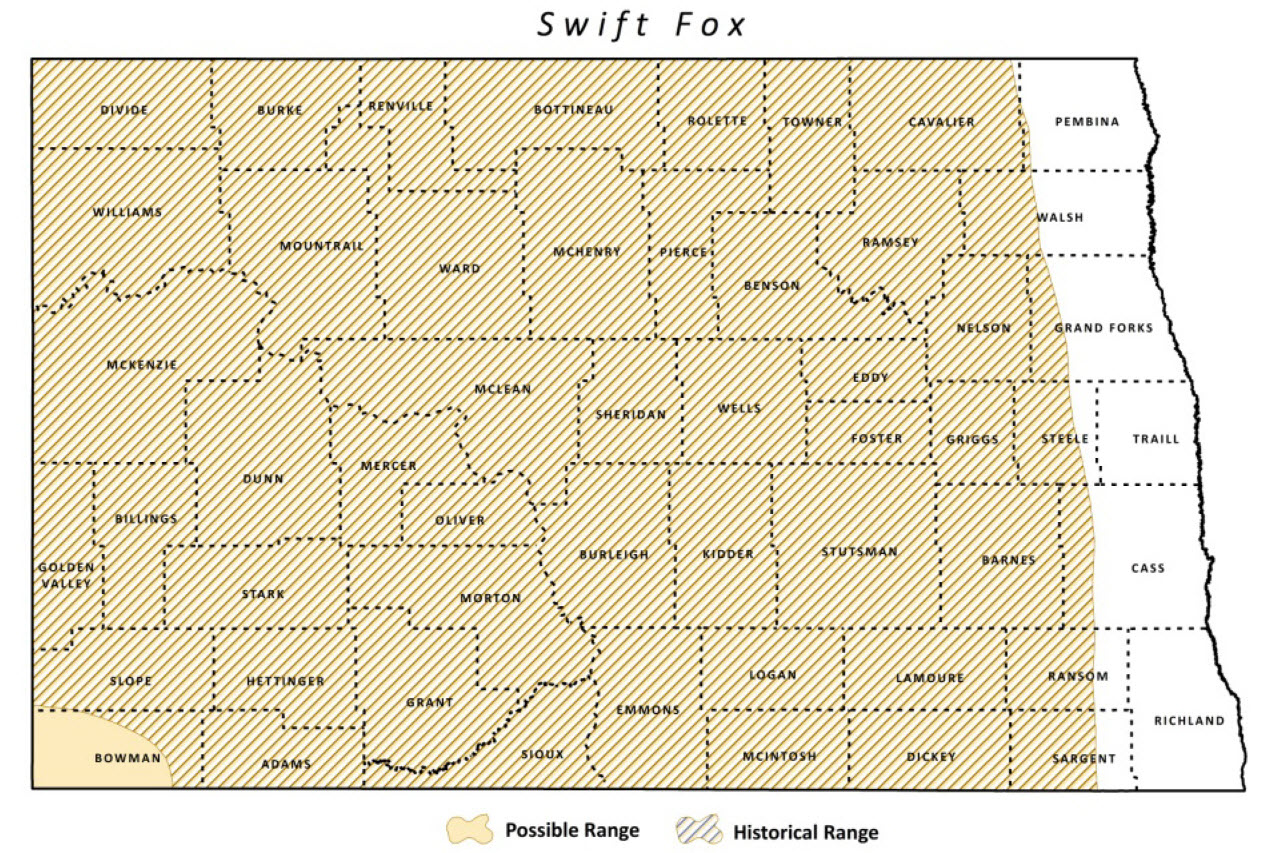
Swift Fox
| Scientific Name | Vulpes velox |
|---|---|
| General Description | Smallest member of the canine family. 2 ½ feet from snout to tip of tail. Yellowish tan coat with some gray along the back. Belly, throat, and chest are buff to white. Distinctly large ears for body size. Long bushy tail with a black tip. |
| Status | Believed to be a resident species, potentially breeding. |
| Abundance | Rare |
| Primary Habitat | Large tracts of short and mixed-grass prairie |
| Federal Status | No federal status |
| Reason for Designation | A combination of loss of native prairie and poisoning efforts aimed at wolves and coyotes are thought to be the cause of initial population decline. The species may have re-established in the state as a result of re-introductions in neighboring states. |
Locations and Conditions of Key Habitat
Preferred Habitat
Found statewide at one time with the exception of the eastern tallgrass prairies. A majority of Swift Foxes were found in the shortgrass prairies of southwestern North Dakota. Swift Foxes prefer large tracts of native prairie, usually grazed, but will select dens sites near agricultural fields and human development.
Key Areas and Conditions for Swift Fox in North Dakota
Shortgrass prairie in extreme western and southwestern North Dakota offers the most suitable habitat for Swift Fox populations in North Dakota. This region is also the closest in proximity to breeding populations in South Dakota and Montana.
Problems Which May Affect this Species
Habitat
Loss of suitable native short and mixed-grass prairie due to conversion to agricultural and development provide the largest threat to re-establishing populations.
Other Natural or Manmade Factors
High red fox and coyote populations threaten Swift Fox populations due to predation. Distance to breeding populations in South Dakota and Montana is a threat to natural repopulation of suitable habitat in North Dakota.
Research and Survey Efforts
Current Research or Surveys
- The North Dakota Game and Fish Department will begin a survey to evaluate population status in SW North Dakota in 2015.
- Population status of a re-introduced population at Badlands National Park is ongoing.
Previous Research or Surveys
- World Wildlife Fund conducted modeling of potential habitat in SE Montana. Included areas in North Dakota.
- A diet study was performed in Montana on a reintroduced population.
- Prey density studies have been conducted throughout the Swift Fox range with SD, MT, and SK being the closest to North Dakota.
- Denning site selections have been studied in southwestern South Dakota.
- Reintroductions have occurred in parts of Montana, South Dakota and Saskatchewan.
Additional Research or Surveys Needed
- Determine presence of Swift Fox in North Dakota
- Identify existing native shortgrass/mixed-grass prairie ecosystem and other suitable Swift Fox habitats.
Management Recommendations
- Promote habitat conservation and habitat management in suitable Swift Fox habitat.
- Coordinate with federal and state agencies to evaluate current levels of protection of habitat.
- Identify habitat corridors and surrounding areas between habitat blocks for protection.
- Monitor existing and identify new threats to Swift Fox population expansion.
- Promote scientific Swift Fox management and a public education program.
Monitoring Plans
No monitoring plan currently in place. The North Dakota Game and Fish will begin surveys of potential habitat to monitor species re-establishment in the state.
2005-2015 Progress
The Swift Fox maintains a level II ranking. Re-introductions into Montana and South Dakota appear to have paved the way for natural re-establishment of the species in extreme southwestern North Dakota. An effort to monitor that re-establishment will begin in the summer of 2015.

Note: A listing of works consulted when compiling the information on this page may be found in the 2015 State Wildlife Action Plan.
